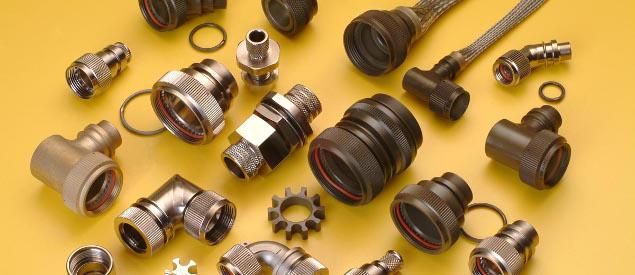
 SAME DAY DISPATCH FOR UK/EU DESTINATIONS
SAME DAY DISPATCH FOR UK/EU DESTINATIONSA variety of adaptors are available for applications in many industries, including aerospace, marine and mass transit, including Solid (sometimes called “fixed”), Spin-Coupling, Spin-Lock, Shielded, Tinel-Lock and Bandstrap. Each is designed to offer a suitable interface between a connector and a heat-shrinkable moulded part. The choice is largely dependent upon the screening level required and the braid termination method.
Adaptor Code
A numerical code is used to identify connectors with similar adapter interfaces. This code is used to determine the adaptor family and part number.
Adaptor Part Number
The part number is the sequence of numbers and letters that describes the adaptor family (or series), size, material, finish and modifications.
Entry Size
Entry size is the diameter of the hole through which the cable enters into the adaptor. For example, the 08 entry is 12.7mm. Entry sizes are specified on shielded and Tinel-Lock adapters only.
Ring Designator
This is a two-letter code that is part of each Tinel-Lock adapter part number. It specifies the size of the TinelLock ring suited to specific types of cable braid.
Shell Size
This is the size of a connector as specified by the connector manufacturer. It is normally a two digit number between 08 and 24, although certain connectors are obtainable in either larger or smaller sizes and some use letter codes.
Order Number
This is a two-digit number that specifies the size of the adaptor that will mate to the corresponding shell size of a connector. The order number is frequently the same as the connector shell size, but should be checked.
Solid Adaptors (Fixed)
Designed for use where no access is required; for example, when potting is necessary or a lower space profile is needed. These adaptors have a boot groove to accommodate a lipped heat-shrinkable boot. Repair cannot be made without removing the boot.
Spin-Coupling Adaptors
Have a rotatable coupling nut and a grooved body, designed to accommodate lipped type heat shrinkable boots. Spin-couplings with an appropriate moulded part are used for environmental protection and strain relief of unscreened cable terminations. Additionally, cable repairs can be made without damaging the boot.
Shielded Adaptors
These are essentially spin-coupling adaptors with a short length of tubular braided shield attached to the rear. The tinned copper wire braid can be pulled down onto a wide range of cable diameters, allowing a standard entry size to be used with most cable sizes. The shield can be terminated to the cable braid using a SolderSleeve device, which provides screen continuity through to the connector.
Tinel-Lock Adaptors
This termination system consists of a modified spin-coupling adaptor with a Tinel-Lock ring. The Tinel-Lock ring is made from a special shape memory metal that shrinks uniformly when heated. The TinelLock ring is used to terminate copper cable braid directly onto the rear of the adaptor. The adaptor entry size and ring designator must be selected to suit the cable diameter and braid type. The resulting 360° termination withstands severe shock, vibration, temperature cycling and corrosion.
Materials & Plating
For a backshell or connector design to perform in different demanding environments and applications, the material and plating selected
are critical to the optimum performance in any given environment. To ensure optimum compatibility, select the adaptor material and finish to match those of the connector and or environment. Recently, high-performance circular connectors and backshells are often manufactured from aluminium, with a black zinc nickel Cadmium-free plating, which are RoHS compliant.
| Material Codes | ||||
| Standard Material Options | Material Part Code | |||
| Group 1 | Group 2 | Group 3 | ||
| Aluminium alloy 6262 / 6082 | 19 | A | 1 | |
| Nickel Aluminium Bronze DGS 1043 / NES 833 (Marine) | 01 | B | 2 | |
| Stainless Steel 303 S31 / 304 | 62 | S | 4 | |
| Non-Standard Materials | Group 1 | Group 2 | Group 3 | |
| Brass CZ 121 | - | - | 3 | |
| Stainless Steel 316 (Marine) | - | - | 46 | |
| HDHC Copper CA 104 | - | - | 5 | |
| Black Acetal (cost effective plastic) | - | - | 7 | |
| PEEK GL30 (30% glass filled) high temperature composite | - | - | 73 | |
| ULTEM 2300 (30% glass filled) standard composite | - | - | 74 | |
ALUMINIUM (A) - Effective for most applications, as satisfies the majority of environmental and interconnect requirements.
Aluminium is strong, lightweight, corrosion resistant and cost effective, with a variety of surface finishes.
NICKEL ALUMINIUM BRONZE (B) - Ideal for marine applications where traditional plating finishes can quickly be eroded revealing weaker base materials, Nickel Aluminium Bronze will remain robust in the harshest of environments.
STAINLESS STEEL (S, 46) - Corrosion resistant steel (CRES) available in 303, 304 and 316 grades, offering excellent corrosion and chemical resistance, plus it is stronger than aluminium and needs no additional plating.
BRASS (3) - Inherently corrosion resistant and being relatively soft, machines easily. It has the added advantage of being non-sparking and
does not require additional surface treatment, but it is often nickel and chrome plated for increased hardness, wear resistance.
COMPOSITE (7, 73, 74) - Key advantages include light weight, corrosion resistance and can be a lower cost when manufactured in high
volumes. Can also be plated for increased surface hardness and conductivity.
Plating Codes
| Standard Plating Options | Colour | RoHS | Plating Part Code | ||
| Group A | Group B | ||||
| Cadmium, per SAE AMS-QQ-P-416, Type II, Class 3.
Over electroless nickel |
Olive Drab | No | B | B | |
| Electroless nickel, per SAE AMS-C-26074, Class 4, Grade B. | Silver | Yes | C | C | |
| Anodised hard per MIL-A-8625, Type III, Class 2 | Black | Yes | G | D | |
| Anodised, sulphuric, MIL-A-8625, Type II, Class 2 | Black | Yes | - | G | |
| Passivated, per SAE AMS-QQ-P-35 or MIL-S-5002
(stainless steel only). |
- | Yes | J | J | |
| Zinc Cobalt over Electroless Nickel | Olive Drab | Yes | U | ZB | |
| Unplated Shot Blast (glass bead), for non-reflective finish | - | Yes | W | Z | |
| Zinc Nickel passivate over electroless Nickel, ASTM B841 class 1 | Black | Yes | Z | ZN | |
| Non-Standard Plating Material | Colour | RoHS | Group A | Group B | |
| Anodised Blue to DEF 03-25 | Blue | Yes | - | AB | |
| Anodised Red to DEF 03-25 | Red | Yes | - | AR | |
| Electroless Nickel, high Phosphor, BS EN ISO 4527:2003 | Silver | Yes | - | CHP | |
| Bright electroless Nickel to MIL-C-26047D, class 4, grade C | Silver | Yes | - | F | |
| Hard anodise Grey | Grey | Yes | - | HA | |
| Iridite conversion of Alocrom 1200, clear/iridescent (aluminium only) | - | Yes | - | ||
| Nickel/PTFE | Black | Yes | - | TN | |
| Unplated clean finish not shot blasted | - | Yes | - | U | |
| Silver plate 5 microns to DEF 03-9 | - | Yes | - | V | |
CADMIUM (B) - The historical standard finish for military and industrial connectors and backshells, offering excellent salt spray corrosion resistance.
ELECTROLESS NICKEL (C) - Commonly used on industrial and high-temperature applications, where a non-reflective finish and high corrosion resistance is not essential.
HARD ANODISED (G) - Used where the need for surface hardness and abrasion resistance is the main criteria. The build up for hard coat
anodising is much thicker than your standard anodising.
PASSIVATED (J) - Removes surface contaminants and produces a surface condition which is resistant to corrosive action. Provides a higher degree of corrosion resistance with finished parts retaining the dimension they had prior to treatment.
ZINC COBALT (U) - Offers enhanced corrosion resistance compared to traditional zinc plating of the same thickness. By electroplating zinc and cobalt to the particular metal, the end result is a uniform ductility.
SHOT BLAST (W) - For a non-reflective finish.
BLACK ZINC NICKEL (Z) - The latest RoHS-compliant solution to environmental plating of connectors and backshells, offering high levels of compatibility with other plating materials.
Screened Backshell Types
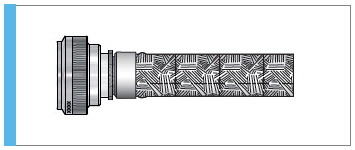 |
BRAIDED TAIL Supplied complete with a braided tail that has been secured by a magna-form crimp ring. Braid shield accommodates a range of cable diameters. This allows a standard entry size to be used with most cable sizes and can be terminated using a SolderSleeve® device. |
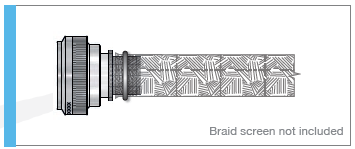 |
MEMORY RING Special shape memory metal ring that shrinks uniformly when heated, offering very secure 360º clamp of the screening braid onto the backshell. Withstands shock, vibration and temperature cycling. Requires specialist tooling. |
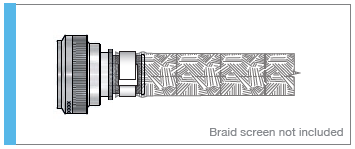 |
BAND CLAMP Where the cable screening braid is clamped to the backshell via a mechanical metal strap. Hand tool required. |
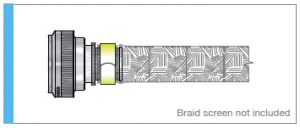 |
ROLL SPRING Cable screening braid is secured to the backshell via constant force spring wrapped around the braid. Does not need any tooling. |
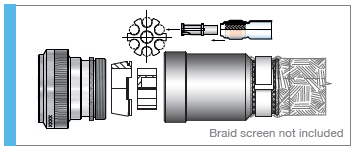 |
INDIVIDUAL SCREEN This system offers the greatest EMI/EMC integrity, providing 360º shielding in the termination area of each individual wire/cable plus collective screen cable versions (shown). The system offers a significant improvement over pigtail termination methods. |
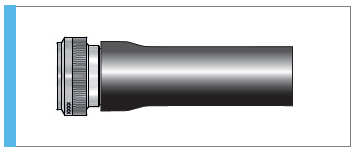 |
BOOT ASSEMBLY Supplied as a complete assembly utilising Rayatan® heat shrink screened boot technology that includes an internal lining that offers shielding levels better than 80 dB at 100 MHz. Avoiding the requirement for a separate metal screening braid. |


